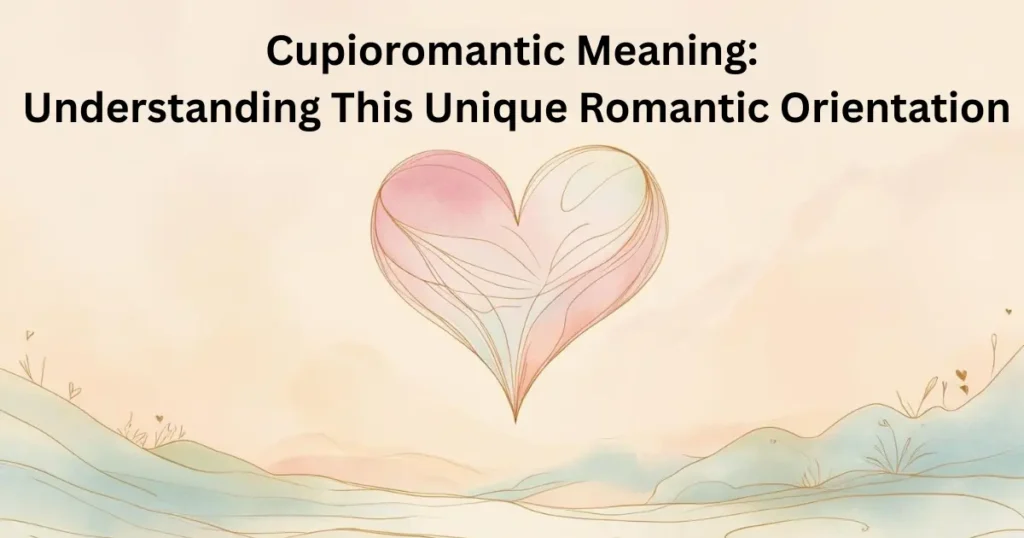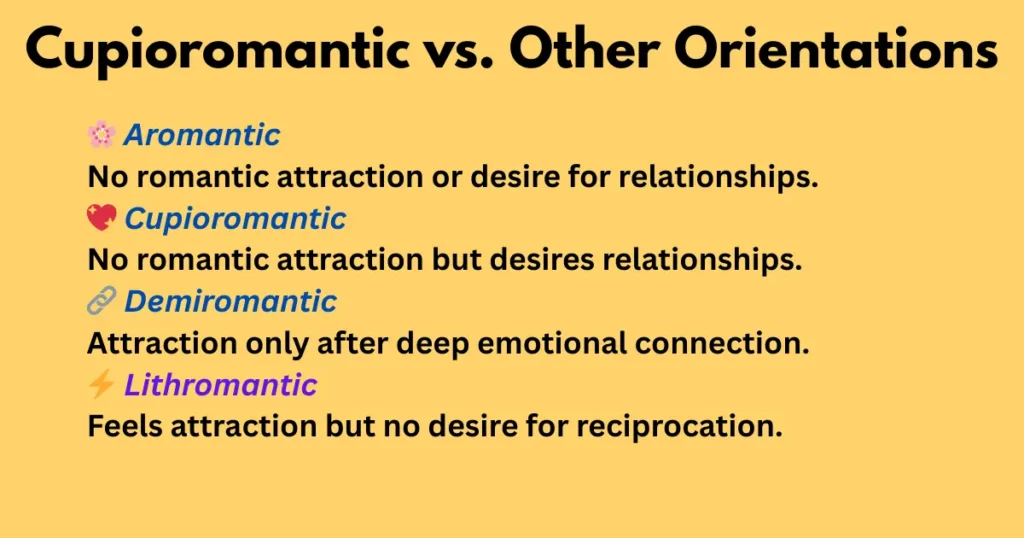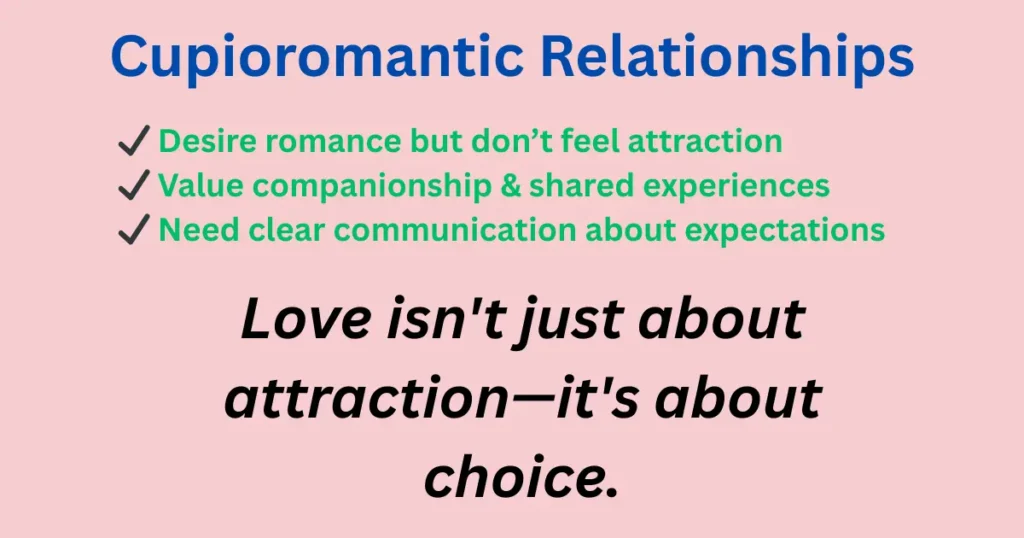Cupioromantic refers to a romantic orientation where a person desires a romantic relationship but does not experience romantic attraction. In other words, cupioromantic individuals want to engage in romantic activities and connections but do not feel the emotional excitement or “spark” that many others do.

What is Cupioromantic Meaning
The cupioromantic meaning describes those who wish for romantic relationships without feeling romantic attraction. While they may want to date, hold hands, or even get married, they don’t experience the typical feelings that accompany romance.
This identity is part of the aromantic spectrum, which includes various romantic orientations like aromanticism and demiromantic. Understanding cupioromantic meaning is vital for self-discovery and connecting with a community that recognizes diverse romantic experiences.
Key Differences Between Cupioromantic and Other Orientations
Cupioromantic vs. Aromantic
- Aromantic: Someone who does not feel romantic attraction and does not desire romantic relationships.
- Cupioromantic: Someone who does not feel romantic attraction but desires romantic relationships.
Cupioromantic vs. Demiromantic
- Demiromantic: A person who only feels romantic attraction after forming a strong emotional bond with someone.
- Cupioromantic: Experiences no romantic attraction but desires romance, emphasizing the cupioromantic meaning.
Lithromantic vs. Cupioromantic
- Lithromantic: This orientation refers to someone who experiences romantic attraction but does not desire those feelings to be reciprocated. In other words, lithromantics can feel a romantic connection but prefer to keep it unrequited.
- Cupioromantic: In contrast, cupioromantics desire romantic relationships but do not experience romantic attraction. They may seek companionship, intimacy, or exclusivity without the emotional rush of romance.
Understanding these differences is vital for individuals exploring their identities within the romantic spectrum.

What Makes Cupioromantic Unique?
| Identity | Feels Attraction? | Wants Romance? | Key Difference |
| Cupioromantic | ❌ No | ✔ Yes | Wants commitment without attraction, highlighting the cupioromantic meaning. |
| Aromantic | ❌ No | ❌ No | No interest in romance |
| Demiromantic | ❌→✔ (after bond) | ✔/❌ Varies | Needs emotional connection first |
| Lithromantic | ✔ Yes | ❌ No | Feels attraction but avoids reciprocity |
Cupioromanticism is often misunderstood as “fear of intimacy,” but it’s actually about authentic desire without attraction—like craving a food you’ve never tasted.
The Cupioromantic Flag & Symbols
The cupioromantic flag is a symbol that represents this identity and helps individuals express their pride. The flag usually has green, white, gray, and black stripes:
- Green represents the desire for romantic relationships.
- White stands for individuality, acknowledging that each cupioromantic person may have different experiences.
- Gray symbolizes the gray area between wanting romance and feeling romantic attraction.
- Black represents the visibility of the cupioromantic community.
This flag fosters a sense of belonging for those who identify as cupioromantic.
Signs You Might Be Cupioromantic
If you are exploring the cupioromantic meaning, consider these signs to see if you might identify with this orientation:
- Desire for Romance: Do you want a romantic relationship but don’t feel attracted to real people?
- Disconnected from Real-Life Romance: Do you enjoy romantic movies or stories, but feel that you cannot relate to actual romantic relationships?
- Lack of Romantic Chemistry: Have you tried dating but never felt the “chemistry” that others talk about?
If you can relate to these experiences, you might be cupioromantic. Understanding your romantic identity is a personal journey, and it’s okay to take your time.
related read: Ghosting in Relationships: Causes, Signs & How to Cope
Cupioromantic Test – How to Know for Sure?
There is no official test to determine if you are cupioromantic, but you can reflect on your feelings. Here are some questions to help you explore your understanding of cupioromantic meaning:
- Do you desire a romantic relationship even if you don’t feel attraction to others?
- Do you connect more with fictional romances than with real-life ones?
- Do you enjoy the idea of romance but find it hard to experience those feelings in reality?
These questions can help clarify if you might identify as cupioromantic. Remember, your identity is yours to define, and no quiz can fully capture your unique experiences.
Is Cupioromantic Valid? Addressing Doubts
Some people question whether labels like cupioromantic are necessary, but these identities are crucial for understanding individual experiences. The aromantic community and mental health professionals recognize cupioromantic meaning as valid, supporting those who feel this way.
Your feelings are real, even if others don’t fully understand them. Embracing your identity can be empowering and help others recognize the diversity of romantic experiences.
Understanding Relationships as a Cupioromantic
Many cupioromantics seek romantic relationships, and there are unique joys and challenges in forming these connections:
Challenges
- Societal Expectations: Society often assumes that romance is a necessary part of any relationship. This expectation can lead to misunderstandings with partners when cupioromantics do not express traditional romantic feelings.
- Communication: It is essential for cupioromantics to communicate openly about their desires and needs to avoid confusion and ensure both partners are on the same page.
Related read:
Sex in Relationships: Key to Love, Trust, and Connection
What is a Platonic Relationship? A Complete Guide
Positive Aspects
- Companionship: Cupioromantics can enjoy the closeness and compatibility that comes with having a partner, even if they do not seek romance in the typical sense.
- Shared Activities: Many cupioromantics value doing things together, such as hobbies or interests, which can strengthen their bond.
Being upfront and honest about being cupioromantic when dating is crucial. Open conversations about what you and your partner want from a relationship can foster understanding and empathy.

Overcoming Stereotypes and Misconceptions
There are many misconceptions surrounding cupioromanticism. For example:
- Misunderstanding of Sexual Orientation: People may assume cupioromantics aren’t interested in sex, but cupioromanticism relates to romantic, not sexual orientation.
- Confusion with Lithromantics: Some may confuse cupioromantics with lithromantics, who feel romantic attraction but do not want those feelings reciprocated.
It is important to educate others about diverse romantic orientations, including cupioromanticism. This helps foster acceptance and support for people with different romantic identities.
Conclusion
In conclusion, understanding cupioromantic meaning is essential for recognizing this valid romantic orientation. If you think you might be cupioromantic, remember that your feelings matter and deserve recognition.
Exploring your romantic identity is a personal journey, and it’s perfectly fine to take your time. For further support and information, consider visiting LGBTQIA+ forums and communities that can help you connect with others who share similar experiences.
Do you think you might be cupioromantic? Share your story in the comments below!
FAQs
How do you pronounce cupioromantic?
It is pronounced “Koo-pee-oh-romantic,” derived from the Latin word ‘cupio,’ meaning desire.
Can cupioromantic people be in relationships?
Yes! Cupioromantic individuals can form romantic relationships and enjoy partnerships, even without feeling romantic attraction.
Is cupioromantic the same as asexual?
No. Cupioromanticism focuses on romantic attraction, while asexuality refers to a lack of sexual attraction. They are different orientations.
How does being cupioromantic differ from being demiromantic?
Demiromantic people only feel romantic attraction after forming a close emotional connection. Cupioromantic individuals do not feel romantic attraction but still desire romantic relationships.
What is the difference between cupioromantic and lithromantic?
Lithromantics experience romantic attraction but do not want those feelings to be reciprocated, while cupioromantics desire romantic relationships without feeling romantic attraction.
What does cupioromantic mean?
Cupioromantic means wanting a romantic relationship without experiencing romantic attraction. It represents a unique orientation within the aromantic spectrum.
Am I cupioromantic?
If you resonate with the desire for a romantic relationship without feeling romantic attraction, you may identify as cupioromantic.
Is there a cupioromantic test?
While there is no official test, reflecting on your feelings and desires can help you understand if you might be cupioromantic.

